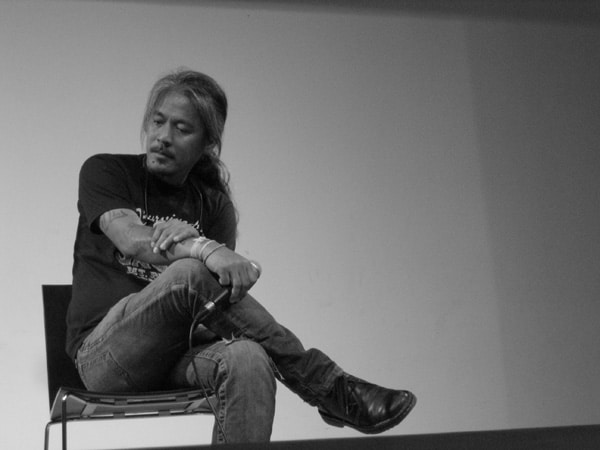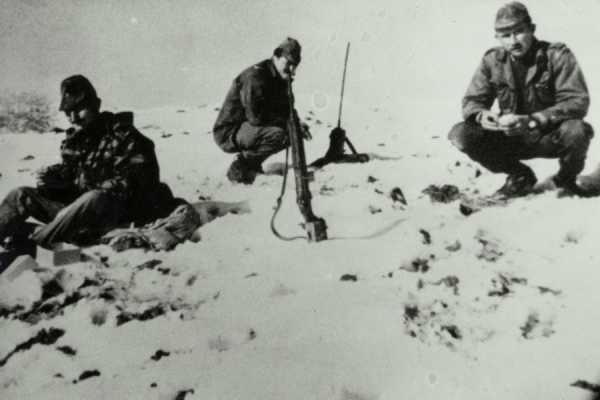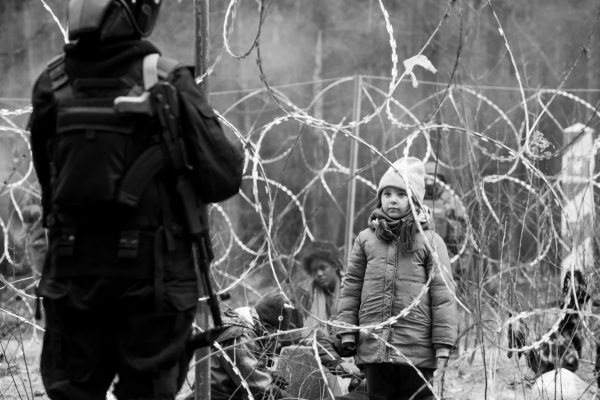Evolution of a Filipino Family (2004), the eleven-hour opus that brought director Lav Diaz worldwide cinephile attention, ends with a title card saying “I know how Jean Vigo died. —Taga Timog, filmmaker.” The easy answer is tuberculosis, but the context is important: the French film director’s anarchic style was butchered by producers during the making of his last film L’Atalante, during which his condition worsened—upholding a family legacy, given Vigo’s militant anarchist father was murdered by an overseer in a jail cell.
Evolution was a critical response to martial law under the Ferdinand Marcos dictatorship and creative repression in the Filipino studio system, its length and obliqueness defying the constraints of commercialization and creating a safe space for stories of the oppressed to be fleshed out, undiluted. Diaz is sometimes referred to as an “elder statesman” for the New Philippine cinema, a movement that responded to the early ’00s dissolution of the Filipino studio system with similarly radical, independent filmmaking. Taga Timog, a pseudonym for Diaz, translates to “from the south”—referring both to Diaz’s birthplace of Maguindanao and his bottom-up approach to politics and filmmaking.
Diaz’s narratives revolve around the prolonged labor processes of the rural poor as they succumb to spiritual malaise and intracommunal bloodshed, linking the disrepair with forgotten history and state violence. They stem from his upbringing as part of a rural family of educators that lived through the U.S.-backed Marcos regime, whose brand of anticommunist (and anti-Muslim) state terror was the latest chapter in centuries-long colonial rule. The Philippines, no longer directly under American colonization or dictatorship, is still suffering from its effects.
Taking cues from the complex narratives of Dostoyevsky and the “time-sculpting” techniques of Slow Cinema godfather Tarkovsky (both of whom are his personal heroes), Diaz uses long takes and sprawling webs to piece together a reality torn apart by political repression. The longer format strips away the mythic symbols of heroic nationalism, colonial development, and capitalist progress embedded by the Marcos years and replaces them with the people they dispossessed and the land they ruined. The intended immersion creates empathy for the characters and denies the dubious rush of accelerationism. While this can be achieved in under two hours (i.e. fellow Filipino Raya Martin's Independencia), the length is crucial for Diaz in representing trauma. Trauma isn’t a consumable commodity; it is a deep-seated knot that takes more than two hours to untangle. In Diaz’s case, it has taken multiple four- to eleven-hour films and counting. Revisiting the same colonized scenario from multiple angles is cinematic therapy, where ritual investigation operates as negotiation with PTSD.
At a recent Harvard Film Archive screening of Storm Children: Book One (2014), Diaz introduced the film by thanking the audience for attending even though Mad Max: Fury Road was playing. While he spoke in jest, there is a palpable connection. Storm Children is a documentary following a handful of Tacloban kids as they explore in the wake of Typhoon Haiyan, but it could easily be speculative post-apocalyptic fiction (see Diaz’s early film Hesus the Revolutionary). The children fish out and examine debris from flooded streets like discovering alien flora, scavenge for the unknown under shores of rubble and repurpose graffiti-laden barges, protruding into the sky with the scale of mother ships in disrepair, into a waterworld-style playground. Storm Children offers even less exposition than Diaz’s other films (I’m thinking of the storm-ravaged feature Death in the Land of Encantos) and, until about halfway through—when some of the kids open up about demolished homes and lost family members—contains barely any dialogue. Diaz captures life in the wreckage with observant but unobtrusive static shots that, in scale, emphasize human reclamation of gargantuan architectural impositions. What could be an exercise in stoking the flames of Western guilt and charitable pity instead displays joyful defiance of circumstances.
In the Q&A after the screening, Diaz told the audience he could follow the kids around without causing community alarm because the locals were used to an invasive media presence. The worst thing he got was an occasional middle finger. Diaz found the kids to be “free” and “autonomous,” a feat considering what he left off-screen: the foreign armies and NGOs. The only white people in the film are goofy, backpacking missionaries awkwardly forcing a sappy moment out of an excitable group of children. The outsider presence is visible in more subtle ways: “WE NEED FOOD AND WATER” spray painted on one of the ships behind a rainy game of hoops.
While this implies government neglect, Diaz pointed out that residents had stockpiles of stuff like cans and socks and that new homes were being built, outside of Tacloban. Thus the portside shantytown is a “resistance . . . against relocation” because “people won’t move from a center of economic activity.” With many typhoons every year, Filipinos face a “vicious cycle of regeneration.” Diaz reserved the word gentrification for the NGO/GI/media complex that turned nearby areas into foreign block parties. At one point Diaz includes his own cough on the soundtrack, disrupting the playfulness with a brief reminder of the ecological damage it’s defying. Filming around toxins and unrecovered bodies landed him in the hospital for pneumonia and microbe infestation.
What remains onscreen is a staggering achievement. The stark approach suggests Diaz is still committed to stripped-down societal reconstruction; he could care less about the commercial prospects offered by recent minor hit Norte, the End of History, whose upgraded camerawork and tightened narrative structure offered accessibility (the long-denied triple crown of a Cannes showing, stateside release and home video distribution). That sort of heightened visibility is usually a success story, but ultimately did no favors to his considered meditations on national trauma, where it is worth capitulating to a longer level of immersion to get the full scope of psychological damage. Not that Diaz is unaware of shorter meditations on temporality, 2011’s six-hour Century of Birthing slyly includes a poster of Tsai Ming-liang’s much shorter What Time is it There? in the studio of a Diaz-like character struggling to finish a movie.
The shift back to uncommercial storytelling makes more sense when taking into account Diaz’s reaction against commercial production. Over the ten years Diaz shot his milestone Evolution, he attempted working within the confines of a studio. He produced four films, drastically cut by producers, all of which he now hates, having made them under the “illusion we could create aesthetic space within a commercial habitat” until realizing it was impossible because the process is controlled by “fucking businessmen.” His first completed independent production was Batang West Side, which begins with a studio-mandated narrative style before freewheeling into self-obliteration. What starts as a procedural about a teen’s death in the New Jersey Filipino community being investigated by one of their own, replete with moralism about a meth variation called shabu, splinters off into a communal portrait of diasporic malaise, where meth is a metaphor for American accelerationism, until it righteously derails into an interrogation of the Marcos legacy, connecting the procedural with fascism.
Evolution, though, is where Diaz liberates himself from the shackles of business-oriented restraint and marks the beginning of his singular approach to history. Switching between 16mm for the early years and digital video for the later ones (before Grand Budapest Hotel’s alternating aspect ratios), with some of the actors aging on camera (predating Boyhood), it spans the period of martial law (from 1971 to 1987) with an elliptical strategy that reiterates the unresolved nature of its tensions. Three generations of a loosely-connected family encounter, among other ailments, anti-rebel military beatings, the haunting mark of imprisonment, indentured servitude, harvest’s endless toil, abandoned gold mines turned into territorial enclaves, an assassination attempt on the Filipino film legend and activist Lino Brocka (appearing in a documentary by the aforementioned Timog) and a twice-orphaned child whose stoic resilience takes on increasingly metaphorical implications. Throughout, a salacious radio soap opera injects the sort of melodramatic approach that the film itself avoids (especially in regard to sexual assault, of which the reverberations are felt without the act being explicitly shown in the film proper).
The dueling formats raise the question of how to tell a nation’s story as it is being erased, as film grain and digital noise rub shoulders with disembodied voices. Diaz uses the format to refract time, either weaving its loose threads back into the historical continuum or allowing its social construct to meet an entropic fate. From Evolution on out, he patiently and carefully simulates competing forms of time, where treacherous landscape and infrastructural neglect dictate manual labor and length of travel, or martial law dictates general livelihood, and discursive conversations (in which Filipino and Tagalog mix with English in a postcolonial negotiation of tongue) offer a brief grip on the clock. From What is Before, not Norte,may be his most accomplished portrait of this sort of spatiotemporal dislocation yet.
Diaz has since switched to digital entirely, combining his old lenses with a handful of newer, affordable cameras. He owns the means of production and, by now in open defiance of market forces, is free to film the harvest in the morning, gold miners in the afternoon, military violence in the evening, and critical dialogues after dinner. Storm Children, in fact, was entirely shot by Diaz and his son—a little smaller than his usual crew. Often, the crew double as actors, comingling with professionals and Lav’s main characters, open space and nature. When asked how many Filipinos actually get to see his films, he laughed: “Not many. Last time I checked there were only seven.” Yet his audience is growing, with campus screenings and outdoor showings at various barrios, meaning that Diaz takes his films to their subjects instead of leaving them to the bourgeois remove of festival screenings or the fickle nature of the standard review cycle.
The HFA also showed Butterflies Have No Memories. Despite its fifty-nine–minute running time, it still managed to cram in a variety of Diaz themes, including Century of Birthing’s autocritique of the artist as potential interloper and knowledge of the past as a tool for manipulation by aspiring fascists. Diaz senses a new revisionism that casts past villains in a positive light, and aims to “throw history to my people” so as to arm them with “discourse.” He acknowledged that he too “could be accused of revisionism” but is “trying to be truthful.” Butterflies was followed by Prologue to the Great Desaparecido, a short that merely announces the intention to make an epic about Andres Bonifacio, a Filipino revolutionary disappeared while revolting against the Spanish. It has the potential to get closer to root cause than any of his preceding works, fleshing out that historical canvas. If those thirty minutes are any indication, Diaz will avoid the epic battles of standard period pieces, opting to focus on physical aftermath, and balance out the masculine excess of colonial affairs with equal concern for the roles of women.
While this suggests an intense, brooding figure, Diaz was easygoing and jovial at the HFA. He ended by introducing the following week’s Melancholia as being, well, “eight hours” and “sad” but also being about the “lives and loves of desaparecidos, missing people from the Marcos years, when 10,000 were disappeared, killed or tortured.” Fittingly, Melancholia investigates collective trauma through an experimental form of group therapy. The instructions for intermissions during the series have gone from “none” to “maybe one if it’s longer than six hours,” something Diaz inadvertently dispelled as absurdly rigid viewing requirements by telling us we could leave in the middle, make love with a partner, get married, smoke weed if we have any—which David Pendleton of the HFA amended with “OUTSIDE!”







